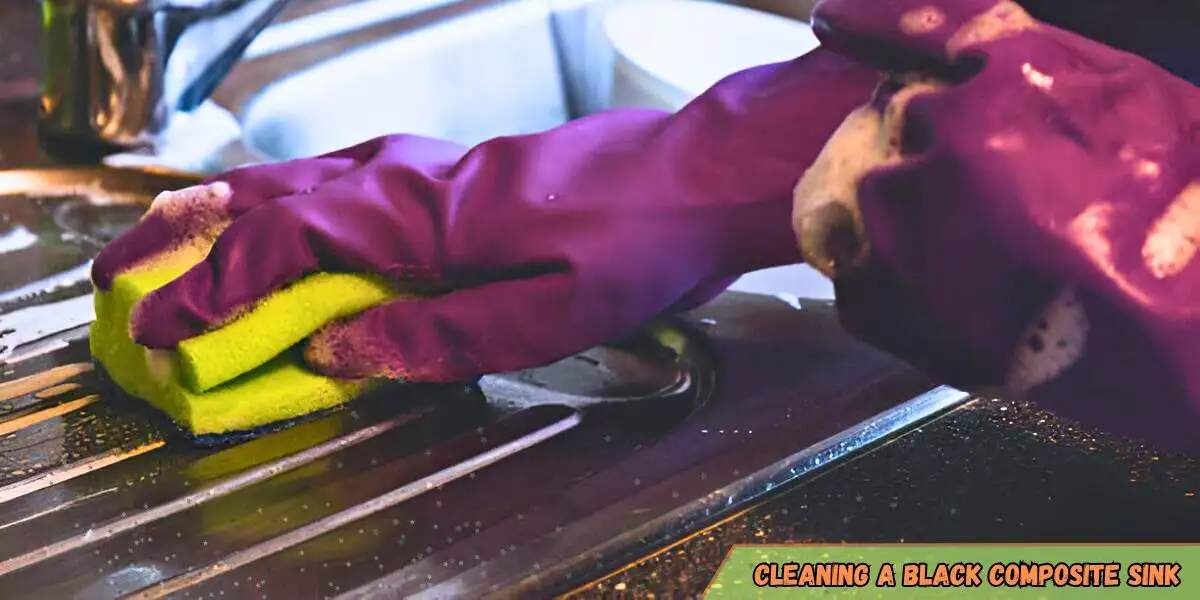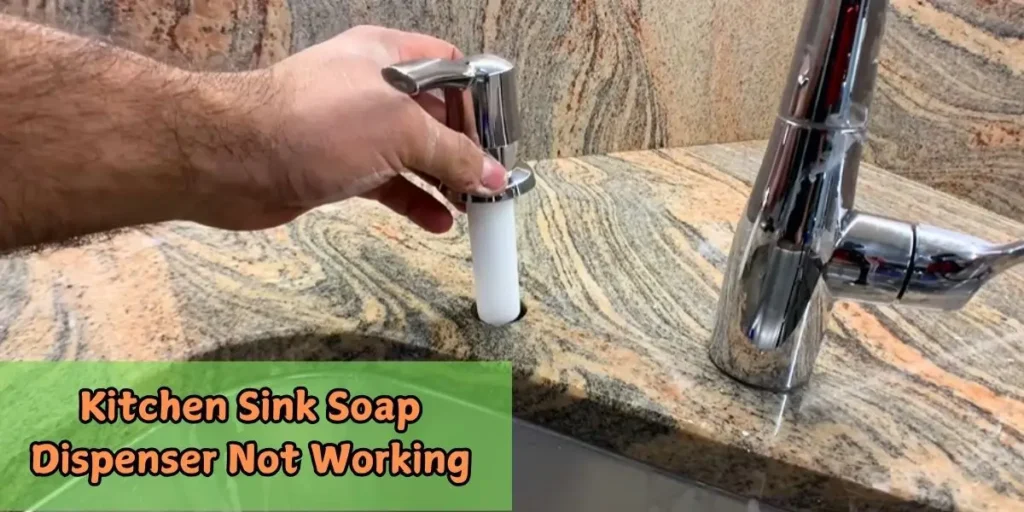How to Clean a Black Composite Sink: Step-by-Step Guide
To clean a black composite sink, use mild soap and a soft sponge. Rinse thoroughly and dry with a microfiber cloth.
Black composite sinks are famous for their durability and sleek appearance. Regular cleaning helps maintain their look and functionality. Avoid abrasive cleaners and tools that can scratch the surface. Dish soap and a soft sponge effectively remove daily grime without damaging the sink.
Rinsing exhaustively ensures no soap residue remains, preventing water spots. Drying with a microfiber cloth adds shine and prevents streaks.
Baking soda can tackle stubborn stains without scratching. A mixture of white vinegar and water can disinfect and remove mineral deposits. Proper care keeps your black composite sink looking new and extends its lifespan.

Why Proper Cleaning Is Essential For Black Composite Sinks
Proper cleaning maintains the beauty and durability of black composite sinks. Use gentle cleansers and soft sponges to avoid scratches. Regular care prevents stains and keeps the sink looking new and shiny.
Cleaning a black composite sink requires a special touch. Although this type of sink looks stunning, it can quickly show wear and tear. Regular maintenance and proper cleaning are essential.
Prevents Stains And Discoloration
Black composite sinks are prone to stains. With regular cleaning, stains become more accessible to remove.
- Food Debris: Black composite sinks can absorb food stains, causing discoloration.
- Hard Water: Mineral deposits from hard water can leave white spots.
- Chemical Reactions: Certain cleaners can cause the sink to lose its rich color.
Maintains Aesthetics And Shine
Keeping your black composite sink clean ensures it looks as good as new.
Regular cleaning buildups buildup that dulls the sink’s finish, helping it retain its sleek, polished look.
Extends Sink Lifespan
Proper care means your sink will last longer. Cleaning prevents damage that can lead to costly repairs.
- Scratches: Dirt particles can scratch the surface.
- Corrosion: Certain substances can cause the material to corrode.
- Cracks: Regular maintenance helps identify and fix minor issues before they become significant problems.
Enhances Hygiene And Safety
A clean sink isn’t just about looks. It’s also crucial for hygiene.
Regular cleaning removes bacteria and food particles. This prevents unpleasant odors and promotes a healthier kitchen environment.
How Often Should You Clean A Black Composite Sink?
Clean a black composite sink weekly to maintain its shine and prevent stains. Use mild soap and a soft cloth for best results.
A black composite sink is a stylish addition to any kitchen. However, to keep it looking its best, it requires regular maintenance. Understanding how often to clean your sink is crucial for maintaining its beauty and functionality.
Related: How to Clean Granite Composite Kitchen Sink: Expert Tips
Daily Cleaning Routine
Daily cleaning is essential to keep your black composite sink in top condition. Here are some quick tasks to include in your routine:
- Wipe down the sink: Use a soft cloth to remove food particles and water spots.
- Rinse thoroughly: Ensure no soap or residue is left behind.
- Dry with a towel: Prevent water spots by wiping the sink dry after each use.
Weekly Deep Clean
A weekly deep clean helps build buildup and keeps your sink pristine. Here’s what to do:
- Use a gentle cleanser: Opt for a non-abrasive cleaner to avoid scratching the surface.
- Scrub with a soft brush: Remove stains or grime without damaging the sink.
- Rinse and dry: Always finish by rinsing and drying the sink to prevent water spots.
Monthly Maintenance
Monthly maintenance helps address any stubborn stains or mineral deposits. This ensures your sink maintains its sleek appearance:
- Apply a baking soda paste: Mix baking soda with water to create a paste and apply it to stains.
- Scrub gently: Use a soft brush to work the paste into the stains.
- Rinse and dry: Thoroughly rinse and dry the sink to leave it spotless.
Signs You Need To Clean More Frequently
Sometimes, your sink may need extra attention. Look out for these signs:
- Water spots and stains: Frequent occurrence means you should clean more often.
- Foul odors: Indicates trapped food particles or residue.
Benefits Of Regular Cleaning
Regular cleaning keeps your sink looking tremendous and prolongs its lifespan. Here are some benefits:
- Prevents stains: Regular cleaning stops stains from setting in.
- Maintains shine: Keeps your sink looking new and shiny.
- Reduces bacteria: Frequent cleaning minimizes bacterial growth.
Things To Know Before You Begin
Proper cleaning ensures your black composite sink stays pristine. Gather non-abrasive cleaners and soft sponges to prevent damage. Regular maintenance helps retain the sink’s elegant appearance.
Black composite sinks are sleek additions to any kitchen. Proper cleaning is essential to keeping them looking their best. Before diving into the cleaning process, there are a few critical things to know.
Related: Apartment Kitchen Sink Backup
Understand Your Sink Material
Knowing what your sink is made of is crucial.
- Composite material: Composite sinks are made from a blend of granite, quartz, and resin.
- Durability: They are highly durable and resistant to scratches and stains.
- Maintenance: Requires specific cleaning methods to prevent damage.
Gather Necessary Supplies
Having the right tools makes cleaning easier.
- Soft sponge: Prevents scratches on the sink’s surface.
- Mild dish soap: Effective for regular cleaning without causing damage.
- Baking soda: Natural abrasive for tough stains.
- White vinegar: Helps to remove water spots and mineral deposits.
Avoid Harsh Chemicals
It’s essential to be cautious with the products you use.
- No bleach: Can discolor and damage the composite material.
- No abrasive cleaners: They can scratch the surface and diminish the sink’s appearance.
- No steel wool: Too rough and can cause permanent damage.
Test Cleaning Products
Testing is essential before using any product.
Always test a small, inconspicuous area of the sink first. This ensures the cleaner will not damage or discolor the sink.
Regular Maintenance Routine
Keeping your sink clean daily helps maintain its beauty.
- Weekly deep clean: Keep stains and grime at bay.
Tools And Supplies You’ll Need
To clean your black composite sink efficiently, gather mild dish soap, a soft sponge, white vinegar, baking soda, and a soft cloth. These essential tools ensure a thorough and gentle cleaning process.
Cleaning a black composite sink can seem daunting, but it is a breeze with the right tools and supplies. Let’s examine what you’ll need to clean it.
Soft Sponge Or Cloth
A soft sponge or cloth ensures you won’t scratch the surface.
- Soft Sponge: Perfect for gentle scrubbing without causing damage.
- Microfiber Cloth: Ideal for wiping down and polishing.
Mild Dish Soap
Mild dish soap is essential for breaking down grime and stains.
Baking Soda
Baking soda is a versatile cleaning agent.
- Stain Remover: Mix with water to create a paste to tackle tough stains.
- Deodorizer: Neutralizes odors and keeps the sink smelling fresh.
Related: Why Does My Bathroom Sink Smell Like Sewer? Causes & Fixes
White Vinegar
White vinegar helps to disinfect and break down mineral deposits.
Soft-bristle Brush
A soft-bristle brush is excellent for detailed cleaning.
- Bristle Brush: Reaches into crevices and corners.
- Non-Abrasive: Ensures no scratches on the sink’s surface.
Rubber Gloves
Protect your hands from harsh chemicals and prolonged exposure to water.
Paper Towels Or Dry Cloth
Drying the sink after cleaning prevents water spots.
- Paper Towels: Quickly soak up excess water.
- Dry Cloth: Ideal for a streak-free finish.
The right tools and supplies can make cleaning your black composite sink simple. With these items, you’ll be well-prepared to keep your sink looking its best.
Step-by-step Instructions To Clean A Black Composite Sink

Discover the best way to clean a black composite sink with these simple steps. First, gather your cleaning supplies. Next, apply a mild cleaner and gently scrub. Rinse thoroughly and dry with a soft cloth for a spotless finish.
Cleaning a black composite sink can seem daunting, but it doesn’t have to be. You can keep your sink pristine and elegant with the proper steps and materials. Follow these step-by-step instructions to make the process straightforward and effective.
Gather Your Cleaning Supplies
First, ensure you have all necessary cleaning materials on hand. This will make the process smoother and quicker.
- Soft cloth or sponge: Gentle on the sink’s surface.
- Dish soap: Effective for everyday cleaning.
- Baking soda: Tackles tough stains.
- White vinegar: Helps with hard water spots.
- Soft-bristle brush: Reaches crevices and corners.
- Microfiber cloth: Perfect for drying and polishing.
Daily Cleaning Routine
Maintaining your sink every day prevents buildup and keeps it shining. Here’s a simple daily cleaning routine:
- Rinse the sink: Use warm water to remove food particles or debris.
- Apply dish soap: Add a few drops to a soft cloth or sponge.
- Scrub gently: Clean the sink’s surface with light, circular motions.
- Rinse thoroughly: Remove all soap residues.
- Dry with microfiber cloth: Prevents water spots and streaks.
Removing Stubborn Stains
Stains can be persistent and require more effort. Use these steps for stubborn stains:
- Sprinkle baking soda: Cover the stained area.
- Add white vinegar: It will fizz and help lift the stain.
- Scrub with a soft-bristle brush: Focus on the stained spots.
- Rinse with warm water: Ensure all residue is washed away.
- Dry with microfiber cloth: Keep the sink looking polished.
Addressing Hard Water Spots
Hard water spots can dull the appearance of your sink. Here’s how to handle them effectively:
- Mix white vinegar and water: Use a 1:1 ratio solution.
- Spray the solution: Target areas with hard water spots.
- Let it sit: Allow the solution to work for a few minutes.
- Scrub gently with a soft cloth: Remove the water spots.
- Rinse thoroughly: Ensure no vinegar remains.
- Dry with microfiber cloth: Restore the sink’s shine.
Deep Cleaning
Deep cleaning your black composite sink once a week ensures longevity and maintains its luster. Follow these steps for a thorough clean:
- Plug the drain: Fill the sink with warm water.
- Add dish soap: Mix well into the water.
- Soak for 10-15 minutes: Loosen any grime buildup.
- Drain the sink: Let the water and soap mixture go.
- Scrub with a soft cloth: Clean the entire surface.
- Rinse thoroughly: Wash away all soap residues.
- Dry with a microfiber cloth: Achieve a streak-free finish.
Special Care For Black Composite Sinks
Maintaining a black composite sink’s pristine look involves soft cleaning with mild dish soap and a soft cloth. Regularly rinse and dry to prevent water spots and soap residue. Use baking soda for tough stains, followed by a thorough rinse.
Black composite sinks are stylish and durable yet require special care to maintain their beauty. Regular cleaning helps, but special care ensures your sink stays in top condition for years. Here are some specific tips for caring for your black composite sink.
Use Gentle Cleaners
Harsh chemicals can damage the surface of your sink. Opt for mild solutions instead:
- Dish soap: Mix with warm water to clean the sink’s surface.
- Baking soda: Acts as a gentle scrub for tough stains.
- White vinegar Can help with mineral deposits.
Avoid Abrasive Tools
Using the right tools can prevent scratches and prolong the life of your sink:
- Soft sponges: Ideal for everyday cleaning without scratching.
- Microfiber cloths: Perfect for wiping down after each use.
- Avoid steel wool: It can cause permanent damage and scratches.
Regular Maintenance Routine
A consistent cleaning schedule keeps your sink looking new. Here’s a simple routine to follow:
- Daily: Rinse and wipe down after each use.
- Weekly: Deep clean with a mild cleaner.
- Monthly: Check for stains and treat them immediately.
Protect From Extreme Temperatures
Black composite sinks can be sensitive to temperature changes. Follow these tips to avoid damage:
- Avoid pouring boiling water directly: This can cause cracks and discoloration.
- Use sink mats: Helps to protect the surface from hot pots and pans.
- Allow hot items to cool Before placing them in the sink.
Address Stains Promptly
Quick action on stains can prevent long-term damage. Here’s what to do:
- Coffee and tea stains: Use a baking soda paste.
- Hard water spots: Treat with a vinegar solution.
- Food particles: Rinse and clean immediately to avoid staining.
Prevent Water Spots And Mineral Deposits
Water spots and mineral deposits can dull the appearance of your sink. Here are some preventative measures:
- Dry after each use: Use a soft cloth to wipe dry.
- Use a water softener: It helps reduce mineral deposits.
- Apply a protective sealant, which adds an extra layer of protection.
How To Maintain And Protect Your Black Composite Sink For Longevity
Clean a black composite sink regularly with mild detergent and warm water. Avoid abrasive cleaners to prevent scratches. Dry thoroughly after washing to maintain its sleek appearance.
A black composite sink can be the centerpiece of your kitchen. Keeping it pristine ensures it remains a stylish addition for years. Regular maintenance and protection are crucial to its longevity.
Daily Cleaning Routine
To keep your sink looking new, a simple daily routine is essential:
- Rinse thoroughly: Remove food particles and debris.
- Use mild soap: Clean with a soft sponge and gentle dish soap.
- Rinse and dry: Prevent water spots by wiping with a soft cloth.
Avoid Harsh Chemicals
Using the right cleaning products is crucial. Some chemicals can damage your sink’s surface:
- Bleach: Avoid it as it can cause discoloration.
- Ammonia-based cleaners: These can weaken the composite material.
- Abrasive pads: Steer clear to prevent scratches.
Regular Deep Cleaning
Once a week, give your sink a deeper clean. This ensures that any build is removed effectively:
- Baking soda paste: Mix with water and scrub gently.
- Vinegar rinse: Use to dissolve any lingering deposits.
- Dry thoroughly: Always dry the sink to avoid water spots.
Protect From Stains
Keeping stains at bay is vital for maintaining the sink’s beauty. Follow these simple tips:
- Avoid leaving acidic foods: Citrus and vinegar can stain if left too long.
- Clean spills immediately: Prevent stains by wiping up spills right away.
- Use a protective grid: This helps to avoid scratching and staining from heavy pots.
Prevent Heat Damage
Heat can damage your sink, so it’s essential to take precautions:
- Use trivets: Place hot pots and pans on trivets, not directly in the sink.
- Avoid thermal shock: Don’t pour boiling water directly into the sink.
- Let cookware cool: Allow hot items to cool before placing them in the sink.
Polish For Shine
Make your sink shine with regular polishing:
- Use mineral oil: Apply a small amount and buff it with a soft cloth.
- Polish monthly: Keep the sink looking new and vibrant.
How To Prevent And Remove Scratches
Use a non-abrasive cleaner and :
- Use a cloth to clean a black composite sink.
- Gently scrub in circular motions to remove grime.
For tough stains, apply a baking soda paste and rinse thoroughly.
Keeping your black composite sink scratch-free can be a challenge. This guide will help you prevent and remove scratches, ensuring your sink remains pristine.
Preventing Scratches
Protecting your sink from scratches involves a few simple steps. Here’s how you can keep your black composite sink looking new:
- Use Sink Mats: Place mats at the bottom to prevent scratches from utensils and dishes.
- Avoid Abrasive Cleaners: Use mild cleaners to avoid damaging the surface.
- Rinse Thoroughly: After using cleaning products, rinse well to prevent residue that can cause scratches.
- Be Gentle: Place items gently in the sink rather than dropping them.
Removing Light Scratches
Even with precautions, light scratches can appear. Here’s how to tackle them:
Light scratches can be removed using household items. Follow these tips for a quick fix.
- Baking Soda Paste: Mix baking soda with water to form a paste. Rub gently on the scratch.
- Non-Abrasive Cleaner: Apply a non-abrasive cleaner and use a soft cloth to buff the area.
- Toothpaste: Use non-gel toothpaste as a polishing agent. Rub with a circular motion.
- Mineral Oil: Apply a small amount of mineral oil to a cloth and rub the scratch to blend it.
Dealing With Deep Scratches
Deep scratches need more effort but can still be managed. Here’s what you can do:
Specific methods are required to restore the sink’s appearance for deeper scratches.
- Sandpaper: Use fine-grit sandpaper, wet it, and gently sand the scratch.
- Repair Kit: Purchase a composite sink repair kit and follow the instructions.
- Polishing Compound: Apply a polishing compound and buff the surface to remove the scratch.
- Professional Help: If deep scratches persist, consider contacting a professional for repair.
Regular Maintenance Tips
Regular maintenance can prevent scratches and extend the life of your sink. Here are some tips:
- Clean Daily: Wipe the sink with a soft cloth and soapy water daily.
- Dry Thoroughly: After cleaning, dry the sink to prevent water spots and mineral deposits.
- Use a Cutting Board: Always use a cutting board to avoid direct contact with the sink’s surface.
- Inspect Regularly: Check for scratches and address them promptly to prevent worsening.
Eco-friendly Cleaning Methods For Composite Sinks
Cleaning a black composite sink with eco-friendly methods preserves its shine and durability. Gently remove stains with a mixture of baking soda and vinegar. Rinse thoroughly with warm water for a spotless finish.
Keeping your black composite sink clean doesn’t have to be a chore. Using eco-friendly methods can help you achieve a sparkling sink without harming the environment. Let’s explore some practical and green cleaning techniques.
Baking Soda And Vinegar
A simple mix of baking soda and vinegar can work wonders. These household items are both powerful and safe for your sink.
- Baking Soda Paste: Mix baking soda and water to create a paste. Apply it to the sink surface.
- Vinegar Spray: Spray white vinegar over the baking soda paste. This will cause a fizzing reaction.
- Scrub and Rinse: Gently scrub with a soft brush and rinse thoroughly with water.
Lemon Juice And Salt
Lemon juice is a natural disinfectant and an excellent deodorizer. Paired with salt, it can effectively clean your sink.
Combine the following for a powerful clean:
- Lemon Juice: Squeeze fresh lemon juice into a bowl.
- Salt: Add salt to the lemon juice to create a thick paste.
- Apply and Scrub: Spread the paste on the sink and scrub with a soft cloth.
- Rinse with Water: Rinse off the mixture with warm water.
Dish Soap And Warm Water
Sometimes, all you need is a little dish soap and warm water. This method is gentle yet effective for regular cleaning.
Use this simple solution:
- Dish Soap: Add a few drops of eco-friendly dish soap to a bowl of warm water.
- Soft Sponge: Dip a soft sponge into the soapy water.
- Scrub the Sink: Gently scrub the sink in circular motions.
- Rinse Thoroughly: Rinse the sink with warm water to remove soap residue.
Hydrogen Peroxide
Hydrogen peroxide is another eco-friendly option. It can help remove stains and disinfect your sink.
Follow these steps:
- Apply Hydrogen Peroxide: Pour hydrogen peroxide directly onto the stained areas.
- Let it Sit: Allow it to sit for a few minutes to break down stains.
- Scrub with a Brush: Gently scrub the sink with a soft brush.
- Rinse with Water: Rinse thoroughly with water.
Olive Oil For Shine
Olive oil can bring back the shine to your black composite sink. It’s a natural way to keep your sink looking new.
Here’s how to use it:
- Apply Olive Oil: Pour a small amount of olive oil onto a soft cloth.
- Buff the Sink: Gently buff the sink surface with the fabric.
- Remove Excess Oil: Wipe away any excess oil with a dry cloth.
Addressing Long-term Care And Maintenance
Maintaining the elegance of a black composite sink involves regular cleaning with mild soap and warm water. Use a non-abrasive sponge to avoid scratches. Mixing baking soda and water works wonders for tough stains, ensuring your sink remains pristine and stylish.
Keeping your black composite sink looking new requires dedication. However, with proper long-term care and maintenance, you can ensure it remains pristine and functional for years.
Regular Cleaning Routine
Maintaining a regular cleaning routine is essential. Here are some quick tips to keep in mind:
- Use mild soap: Prevents damage and maintains the sink’s finish.
- Soft cloth or sponge: Avoids scratches and preserves the surface.
- Rinse thoroughly: Removes soap residues that could dull the finish.
Avoiding Harsh Chemicals
To keep your sink in top condition, avoid harsh chemicals. These substances can damage the sink’s surface. Opt for gentle, eco-friendly cleaning solutions instead. This approach not only protects your sink but also the environment.
Preventing Stains And Discoloration
Stains and discoloration can be a nuisance. Simple habits can help prevent them:
- Rinse after use: Removes food particles and residues.
- Wipe spills immediately: Prevents staining from strong-colored substances.
- Use a sink mat: Protects against scratches and discoloration.
Deep Cleaning Techniques
Occasionally, your sink might need a deep clean. Here’s how to do it effectively:
- Baking soda paste: Mix baking soda with water for a gentle scrub.
- Vinegar rinse: Helps remove mineral deposits and soap scum.
- Soft brush: Reaches into corners and crevices for thorough cleaning.
Protecting The Sink Surface
The sink surface needs protection from potential damage. Implement these practices:
- Avoid abrasive tools: Prevents scratches and preserves the finish.
- Use cutting boards: Avoid direct contact with sharp knives.
- Regular sealing: Keeps the surface resistant to stains and discoloration.
Maintaining Shine And Luster
Keeping your sink shiny enhances its aesthetic appeal. Here are some tips:
- Olive oil polish: Adds a natural shine without harmful chemicals.
- Buff with a soft cloth: Maintains the sink’s luster.
- Routine care: Ensures the sink remains sparkling over time.
Dealing With Hard Water Deposits
Hard water deposits can be particularly stubborn. Here’s how to tackle them:
- Vinegar soak: Loosens and dissolves mineral deposits.
- Soft scrubbing pad: Removes deposits without scratching.
- Regular descaling: Keeps deposits from building up over time.
Ensuring Proper Drainage
Proper drainage prevents water from pooling and causing issues. Make sure to:
- Clean the drain regularly: It avoids clogs and slow drainage.
- Use a drain cover: Prevents debris from entering and causing blockages.
- Check for leaks: Ensures the plumbing is functioning correctly.
Handling Scratches And Chips
Scratches and chips can detract from your sink’s appearance. Address them promptly:
- Sandpaper: Smooths out minor scratches.
- Epoxy resin: Repairs chips and restores the surface.
- Professional repair: For severe damage, consider expert help.
Seasonal Maintenance Tips
Adapting your care routine seasonally can make a difference. Consider these tips:
- Winter care: Prevents damage from cold temperatures.
- Summer maintenance: Handles increased use during warmer months.
- Periodic inspections: Identifies potential issues before they become serious.
Frequently Asked Questions (FAQs)
Use mild dish soap, water, and a soft cloth. Rinse thoroughly and dry with a microfiber towel.
Baking soda paste and a soft brush can remove stains. Rinse well and wipe dry.
Avoid bleach. It can damage the sink's surface. Use mild cleaners instead.
Clean daily with mild soap and a deeper cleaning routine weekly to maintain its appearance.
Vinegar is safe for occasional use. Dilute with water to prevent potential etching. Rinse thoroughly.
Conclusion
Keeping your black composite sink clean is simple with the proper techniques. Regular maintenance prevents stains and preserves its beauty. For the best results, use gentle cleaners and avoid abrasive tools. Follow these tips to enjoy a spotless, elegant sink that enhances your kitchen’s appeal.
Happy cleaning!
Related Posts
-
 Learn How to Remove Garbage Disposal From Sink 2025
Learn How to Remove Garbage Disposal From Sink 2025 -
 How to Install a Kitchen Sink Sprayer in Simple Steps 2025
How to Install a Kitchen Sink Sprayer in Simple Steps 2025 -
 Simple & Effective: Basement Bathroom Plumbing Diagram
Simple & Effective: Basement Bathroom Plumbing Diagram -
 How Far from Sink Can Dishwasher Be? Key Facts Explained
How Far from Sink Can Dishwasher Be? Key Facts Explained -
 How to Get Instant Hot Water at Kitchen Sink
How to Get Instant Hot Water at Kitchen Sink -
 How to Fix an Airlock in a Kitchen Sink Drain: A Step-by-Step Guide
How to Fix an Airlock in a Kitchen Sink Drain: A Step-by-Step Guide -
 Kitchen Sink Soap Dispenser Not Working? Here’s How to Fix It
Kitchen Sink Soap Dispenser Not Working? Here’s How to Fix It -
 Kitchen Sink Drains into Yard: Causes, Solutions
Kitchen Sink Drains into Yard: Causes, Solutions -
 No Water in Bathroom but Everywhere Else: Expert's Solutions
No Water in Bathroom but Everywhere Else: Expert's Solutions -
 Double Kitchen Sink Plumbing Diagram: A Visual Guide
Double Kitchen Sink Plumbing Diagram: A Visual Guide

